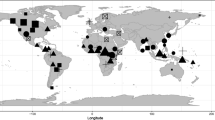Abstract
The dynamics associated with emergent leadership in creative problems solving groups were examined. Contrary to common measurement practice, the frequency distribution of leadership behavior in group was hypothesized to conform to a multimodal exponential probability density function, which was thought to characterize self-organizational processess of the rugged landscape variety. Participants were 140 adults, who were organized into groups of 7-9 players for a group problem solving exercise that began without an appointed leader. Ratings of leadership behavior by each player for each fellow player revealed that clear leaders did emerge, reflecting a form of self-organization within the group. Analysis showed that the obtained frequency distribution was a complex function generated by a swallowtail catastrophe dynamic.
Similar content being viewed by others
REFERENCES
Bass, B.M. (1985). Leadership and performance beyond expectations. New York: Free Press.
Cattell, R. B., & Stice, G. F. (1954). Four formulae for selecting leaders on the basis of personality. Human Relations, 7, 493–507.
Clark, K. E., & Clark, M. B. (Eds.). (1990). Measures of leadership. West Orange, NJ: Leadership Library of America.
Clark, K. E., Clark, M. B., & Campbell, D. P. (Eds.). (1992) Impact of leadership. Greensboro, NC: Center for Creative Leadership.
Cobb, L. (1981). The multimodal exponential families of statistical catastrophe theory. In C. Taillie, G. P. Patil, and B. Baldessari (Eds.), Statistical distributions in scientific work. (Vol. 4, pp. 67–90). Hingam, MA: Reidel.
Evans, M., Hastings, N., & Peacock, B. (1993). Statistical distributions (2nd ed.). New York: Wiley.
Gillan, P.G. (1989). Island Commission: Group problem solving. In J. Pfeiffer (Ed.), Structured experiences in human relations (vol. 7, pp. 99–104). San Diego: J. Pfeiffer and Associates.
Guastello, S. J. (1985). Color matching at the weekly work cycle: An industrial application of the swallowtail-difference equation. Behavioral Science, 30, 204–212.
Guastello, S. J. (1995a). Chaos, catastrophe, and human affairs: Applications of nonlinear dynamics to work, organizations, and social evolution. Hillsdale, NJ: Lawrence Erlbaum Associates.
Guastello, S. J. (1995b). Facilitative style, individual innovation, and emergent leadership in problem solving groups. Journal of Creative Behavior, 29, 225–239.
Guastello, S. J. (in press). Creative problem solving groups at the edge of chaos. Journal of Creative Behavior. Guastello, S. J., & Rieke, M. L. (1993). The 16PF and leadership: Summary of research findings 1954–1992. Technical Report No. 2. Champaign, IL: Institute for Personality and Ability Testing.
Hollander, E. P., & Offermann, L. R. (1990). Power and leadership in organizations: Relationships in transition. American Psychologist, 45, 179–189.
Kauffman, S. A. (1993). The origins of order: Self-organization and selection in evolution. New York: Oxford University Press.
Kenny, D. A., & Zaccaro, S. J., (1983). An estimate of variance due to traits in leadership. Journal of Applied Psychology, 68, 678–685.
Lewin, K., Lippitt, R., & White, R. (1939). Patterns of aggressive behavior in experimentally created “social climates.” Journal of Social Psychology, 10, 271–299.
Lord, R. G., DeVader, C. L., & Alliger, G. M. (1986). A meta-analysis of the relation between personality traits and leadership perceptions: An application of validity generalization procedures. Journal of Applied Psychology, 71, 402–410.
Lotka, A. J. (1926). The frequency distribution of scientific productivity. Journal of the Washington Academy of Science, 16, 317–323.
Lykken, D. T., McGee, M., Tellegen, A., & Bouchard, Jr. (1992). Emergenesis: Genetic traits that may not run in families. American Psychologist, 47, 1565–1577.
Mottram, R. D. (1988). Building effective teams using the 16PF. In K. Miller, (Ed.), The analysis of personality in research and assessment (pp. 131–140). London: Independent Assessment and Research Centre.
Rieke, M.L., Guastello, S.J., & Conn, S.R. (1994). Leadership and creativity. In S.R. Conn & M.L. Rieke (Eds.), Technical manual for the 16PF fifth edition (pp. 183–212). Champaign, IL: Institute for Personality and Ability Testing.
Simonton, D.K. (1988). Creativity, leadership, and chance. In R.J. Sternberg (Ed.), The nature of creativity: Contemporary psychological perspectives (pp. 386–426). New York: Cambridge University Press.
West, B., & Deering, W. (1995). The lure of modern science: Fractal thinking. Singapore: World Scientific.
Zaccaro, S. J., Foti, R. J., & Kenny, D. A. (1991). Self-monitoring and trait-based variance in leadership: An investigation of leader flexibility across multiple group situations. Journal of Applied Psychology, 76, 308–315.
Author information
Authors and Affiliations
Rights and permissions
About this article
Cite this article
Guastello, S.J. Self-Organization in Leadership Emergence. Nonlinear Dynamics Psychol Life Sci 2, 303–316 (1998). https://doi.org/10.1023/A:1022987021965
Issue Date:
DOI: https://doi.org/10.1023/A:1022987021965




